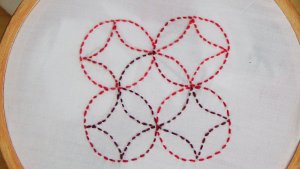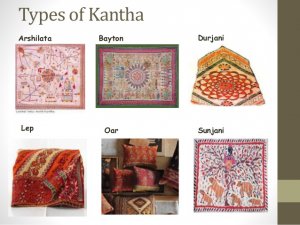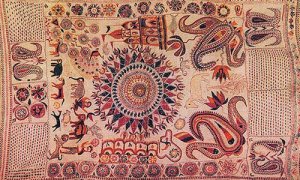Are you looking for Bengali Art- Kantha Embroidery then check out this post to know more. Bengal, a rich heritage, the wide culture, from goddess kaali worship to famous terracota, land loaded with lots of history, and popular for its famous cuisine maach bhaat(fish and rice).
Bengal has an extremely rich heritage of arts, it is an important hub classical south asian arts. Apart from these, there are also numerous ethnic and religious minorities. Bengal is the origin of many arts such as kalighat paintings or scroll painting, apart from this ladies of Bengal are also famous for their embroidery work called kantha.
History of Kantha embroidery
Kantha is one of the oldest forms of embroidery that originated in India. Its origins can be traced back to the ancient pre-Vedic ages. Kantha embroidery includes many symbols that were derived from ancient art.
It was not until later that Kantha embroidery was used as a medium of cultural and religious significance, which came about as a result of Hinduism’s influence and was used in ceremonies and pujas, including to celebrate weddings and births.
The thought behind this work was to reuse old clothes and materials and turn them new. This is what kantha embroidery makes only one of its kind. Traditionally women take 4 to 5 sarees, layer them together and create different running stitches on them which they then act as a quilt or used as blankets to cover their children with.
However, what started as a way to make life more comfortable went on to become a big trend in clothes and furniture as well.

METHOD:
traditionally threads used in Kantha were taken from old sarees and dhotis .which are then coloured by dyes.
dyes were traditionally made of natural substances, which were traditionally used in a wide range of Indian arts and crafts, in contemporary Kantha, the off-white base fabric is usually used to allow the embroidered colours of the threads to catch the eye. design of kantha embroidery is inspired by day to day life and depicts nature symbols that were found in the ancient art such as the tree of life, the sun and the cosmos.
Also, Kantha embroidery includes human figures, flowers and leaves, all of which are naturally part of the landscape of a typical rural India.

There are seven different Kantha items whose names depict their different use:
a) Lep Kantha: rectangular shaped wraps mainly used for the production of padded quilts.
b)Sujani Kantha: pieces of rectangular cloth used to the make the bed covers or spreads for ceremonial occasions.
c) Baiton Kantha: square shaped wraps used in the production of book covers or covers for valuable objects.
d) Oaar Kantha: rectangular shaped pillowcases that feature simple yet alluring motifs and decorative borders.
e) Archilata Kantha: small rectangular shaped covers for mirrors or toiletries that feature an assortment of colourful Kantha motifs and borders.
f) Durjani Kantha: a small rectangular piece of cloth that usually features borders and the lotus motif. The cloth is turned into a wallet with the inward folding of three of its corners.
g) Rumal Kantha: a piece of cloth that usually features borders and the lotus motif in the centre, used to cover plates or as household wipes.

Today’s kantha: Although Kantha embroidery is at its peak of popularity and has been practised by the rural women of West Bengal for over five centuries, recognition of its elaborate craftsmanship dwindled over the years. The revival of the craft in West Bengal can be attributed to organizations.
In West Bengal organisations such as SHE (Self Help Enterprise), almost 16,000 families are working for this art and making this art professional as well. Not only in West Bengal or India but abroad too.

Kantha stitch is very popular amongst the tourists visiting West Bengal, from India as well as abroad. Although whatever be the art whether it is hand stitched or machine worked, arts are irreplaceable.
And hold a very special place in our home and heart. Kantha is emerging and surviving from generation to generation, but still, haven’t faded and loved by many people around the world.


